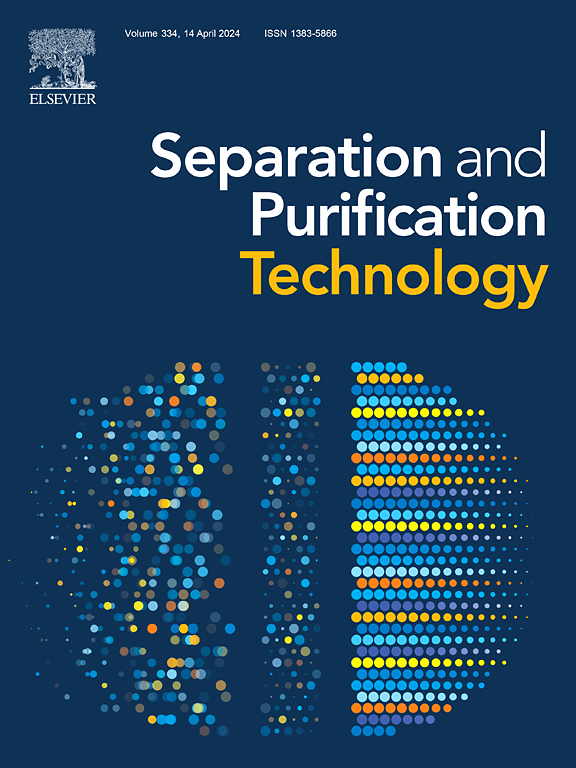Ultra-fast Joule heating synthesis of homogeneous copper-based bimetallic catalysts for electrochemical nitrate-to-ammonium reduction in wastewater treatment
IF 8.1
1区 工程技术
Q1 ENGINEERING, CHEMICAL
引用次数: 0
Abstract
The conversion of nitrate to ammonia presents a promising solution to reduce the energy consumption and carbon footprint associated with the traditional Haber-Bosch process, while also addressing the environmental impacts of nitrate-containing wastewater. To tackle the challenges in catalyst preparation for efficient electrochemical nitrate reduction toward ammonium, this study reports an extremely rapid Joule-heating synthetic method to fabricate a series of copper (Cu)-based bimetallic catalysts. The results demonstrate that the Joule-heating process leads to the formation of well-dispersed and homogeneous bimetallic particles as evidenced by the scanning electron microscope (SEM) and corresponding energy dispersive spectroscopy (EDS), exhibiting an enhanced catalytic activity. Among various samples, the homogeneous copper-nickel (CuNi) catalyst presents an exceptional ammonium selectivity of 98 %, an ammonium yield of 49 %, and an ammonium formation rate of 764 µg h−1 cm−2, which are approximately 2 times higher than Cu monometallic catalyst. This superior activity is attributed to the increased electrochemical active surface area (ECSA) in CuNi materials. Additionally, X-ray photoelectron spectroscopy (XPS) characterization confirms the electronic redistribution within the CuNi structure, revealing a lower oxidation state of Cu, which further contributes to the improved efficiency in the nitrate reduction reaction. Overall, this study enables a new route for the rational design of homogenous bimetallic catalysts in nitrate reduction for wastewater treatment and environmental protection.

超快焦耳加热合成均相铜基双金属催化剂用于废水处理中硝酸盐-铵的电化学还原
将硝酸盐转化为氨提供了一个很有前途的解决方案,可以减少与传统Haber-Bosch工艺相关的能源消耗和碳足迹,同时也解决了含硝酸盐废水对环境的影响。为了解决催化剂制备中硝酸盐高效电化学还原为铵的挑战,本研究报告了一种极快速的焦耳加热合成方法来制备一系列铜基双金属催化剂。结果表明,通过扫描电镜(SEM)和能谱分析(EDS),焦耳加热过程可以形成分散均匀的双金属颗粒,具有较强的催化活性。在不同的样品中,均相铜镍(CuNi)催化剂对铵的选择性为98 %,铵的产率为49 %,铵的生成速率为764 µg h−1 cm−2,约为单金属铜催化剂的2倍。这种优异的活性归因于CuNi材料中电化学活性表面积(ECSA)的增加。此外,x射线光电子能谱(XPS)表征证实了CuNi结构内的电子重分布,表明Cu的氧化态较低,这进一步提高了硝酸盐还原反应的效率。总体而言,本研究为合理设计均相双金属催化剂用于废水处理和环境保护中的硝酸盐还原提供了新的途径。
本文章由计算机程序翻译,如有差异,请以英文原文为准。
求助全文
约1分钟内获得全文
求助全文
来源期刊

Separation and Purification Technology
工程技术-工程:化工
CiteScore
14.00
自引率
12.80%
发文量
2347
审稿时长
43 days
期刊介绍:
Separation and Purification Technology is a premier journal committed to sharing innovative methods for separation and purification in chemical and environmental engineering, encompassing both homogeneous solutions and heterogeneous mixtures. Our scope includes the separation and/or purification of liquids, vapors, and gases, as well as carbon capture and separation techniques. However, it's important to note that methods solely intended for analytical purposes are not within the scope of the journal. Additionally, disciplines such as soil science, polymer science, and metallurgy fall outside the purview of Separation and Purification Technology. Join us in advancing the field of separation and purification methods for sustainable solutions in chemical and environmental engineering.
 求助内容:
求助内容: 应助结果提醒方式:
应助结果提醒方式:


